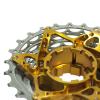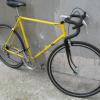konzervativan, on 30 Dec 2015 - 2:38 PM, said:
A da se vratite ponovo na sajt…pre tabele ima i neki tekst.
Nije ni čudo što su mnogi odustali od pisanja na cikloberzi.
Slobodno nastavite...normalno, bez mene.
Meni je stvarno žao što te pogađa kad se ljudi ne slažu sa tobom stoprocentno bez pogovora. Zato verovatno nisi primetio da se ono što piše na Schwalbe sajtu ne kosi praktično ni sa čim što ljudi ovde pišu - samo smo dodali šta treba imati u vidu za korekciju propisanog pritiska, kad i sam proizvođač kaže da taj propisani pritisak služi za orijentaciju, a ne kao zakon.
If the inflation pressure is continuously too low, premature tire wear is the result. Cracking of the sidewall is the typical consequence. Abrasion is also unnecessarily high.
On the other hand, an under-inflated tire absorbs road shocks better. Wide tires are generally used at low pressure. The larger air volume is advantageous in that it absorbs road bumps and holes, but does not suffer from higher rolling resistance, less puncture protection or low tire wear.
The permitted inflation pressure range is marked on the tire sidewall. The higher the inflation pressure, the lower the rolling resistance, the tire wear and the less likelihood of a puncture. The lower the inflation pressure, the higher are the comfort and grip that the tires provide.
The list of inflation pressure recommendations on the right can only provide a very general guide. The recommendations are for an “average rider” weighing about 165 lb (75 kg).
Lighter weight riders or riders who prefer a smooth or more comfortable ride can accordingly choose a lower inflation pressure, but the actual tire pressures should never be higher or lower than the maximum and minimum inflation pressures marked on the tire sidewall.
Ispada da se taj famozni propisani pritisak svodi na vrlo opštu smernicu uz uputstvo da se ne ide iznad ili ispod obeleženog maksimuma. Ili nešto nisam dobro razumeo?































